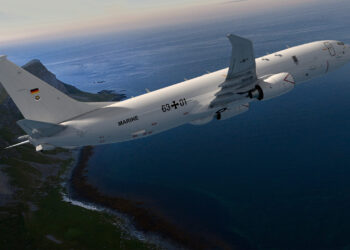US Navy,
USS ENTERPRISE, At Sea: The Chief of Naval Operations (CNO), Adm. Gary Roughead, along with the Commandant of the Marine Corps (CMC), Gen. James Conway and Commandant of the Coast Guard, Adm. Thad Allen released the “Cooperative Strategy for 21st Century Seapower” on Oct 17. As the maritime strategy was released, Enterprise Strike Group (ENTSG) was executing it while forward deployed in the 5th Fleet area of operations.
The new strategy stresses the importance of the Navy's core capabilities of forward presence, deterrence, sea control, and power projection as well as its expanded core capabilities of humanitarian assistance/disaster response and maritime security. ENTSG's assets are currently deployed throughout the Eastern Hemisphere in the performance of those missions.
“We are supporting OEF (Operation Enduring Freedom) today,” said Rear Adm. Dan Holloway, commander, Carrier Strike Group (CCSG) 12. “We are conducting an anti-submarine exercise at the coalition, multi-national level and we are supporting Maritime Security Operations right now while conducting counter-piracy operations.”
Enterprise and embarked Carrier Air Wing (CVW) 1 recently showed the flexibility implicit in the maritime strategy when it shifted from the North Persian Gulf and missions in support of Operation Iraqi Freedom (OIF) to the North Arabian Sea and OEF within hours.
“The primary reason we shifted from OIF to OEF was the OEF commander needed our sorties to support the troops on the ground with close air support for the effort in Afghanistan,” Holloway said.
The ENTSG showed the ability of the Navy's assets to move at a moment's notice.
“I got a call from the admiral telling me, 'Captain you need to turn south,'” said Capt. Ron Horton, Enterprise commanding officer. “By noon, 36 hours later, we were flying operations into Afghanistan.”
Operating in a different part of the world only days apart can present many challenges.
“Many of the missions in OEF are the same types of missions as OIF, but the bottom line is we have a different geographic area,” explained Capt. Mark Wralstad, commander, CVW-1. “We have to study the area, study what units we are supporting and figure out who we are talking to as far as command and control. We had very little notice that we were going to move. It demonstrates our flexibility – that we can pick up from one spot in the world, and move to another part of the world [and] pick up operations at a very fast clip.”
ENTSG isn't involved in combat operations only. One of its units, USS Forrest Sherman (DDG 98), is in the middle of a journey around the continent of Africa, working to foster relationships with other nations and coalition forces.
“Forrest Sherman is basically doing a circumnavigation of Africa,” said Capt. Ralph Tindal, Commander, Destroyer Squadron (CDS) 2. “They have made port visits and done a lot of theater security operations with local African nations along the East Coast, the Southern Coast and Western Africa. This is part of the theater security cooperation initiative. They are working primarily with 6th Fleet to strengthen ties with these local nations to show American intent and interest in what is going on there.”
Destroyers in the ENTSG are also involved in counter-piracy missions off the coast of Africa.
“Anti-piracy in this theater focuses on two different regions,” Tindal said. “One is the Central and Southern [Persian] Gulf where it's sort of considered low-level piracy, sometimes termed thuggery, where vessels innocently fishing or moving commerce are harassed and robbed. There is also a higher level of piracy that is more prevalent along the Horn of Africa where pirates are capturing large ships and holding them for ransom.”
Ships from the ENTSG are patrolling these areas and assisting mariners in distress whenever possible.
The strike group also completed an anti-submarine warfare (ASW) exercise. The ASW training ranged from practicing individual technician skills to coordinating multi-platform deterrent measures. Carrier strike groups hold these exercises routinely to maintain proficiency and demonstrate anti-submarine capabilities.
“This was a routine training exercise to help our forces maintain a full-range of readiness,” said Rear Adm. Dan Holloway, CSG 12. “These exercises also help reassure regional countries of our ability to maintain security for lawful use of the sea.”
The ENTSG, including Enterprise, CVW-1, CDS 2 and CCSG 12, is doing its part to demonstrate the larger maritime strategy.
“Instead of being an individual aircraft carrier, USS Enterprise, with Carrier Air Wing 1, we plug into the bigger portion,” Wralstad said. “There are a lot of different things going on and we plug into all of the mission types.”
Enterprise and CVW-1 exercises a full range of capabilities from traditional operations at sea to the boots-on-the-ground missions performed by the 60 individual augmentees of the ENTSG who are currently part of the Navy's presence in Iraq and Afghanistan.
“Enterprise is the enabler and Air Wing One is the striking arm of this strike group and that is what we bring to the Maritime Strategy,” Horton emphasized. “We have global reach. In a matter of days or weeks, we can reach around the world and we can be there very quickly. We don't need a whole lot of help to do that and we don't need anyone's permission to do that.”
The Enterprise Strike Group will continue to be flexible to create positive effects as well as to build strong relationships with other nations, falling directly inline with the CNO's goals.
“We operate as a joint and combined force,” Holloway said. “We are integrating with coalition forces and balancing our efforts across the full spectrum of combat operations. We believe that by our presence we are building partnerships. The positive feedback we are getting from other nations as well as coalition and U.S. forces speaks highly of the flexibility of the entire strike group.”









